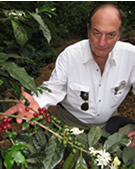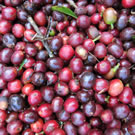Each week I hear about subsistence farmers affected by extended drought, rainy seasons beginning late and ending early, too much rain at the wrong time, and extreme weather events destroying crops. But a trip to a coffee farm in Guatemala brought this reality home to me.
My friend Sergio bought a farm in a mountainous region of Guatemala seven years ago that had been abandoned and abused. Former owners had intensively grown corn on the steepest of hillsides for years—depleting the soil and exposing it to continuous rain driven erosion.
In the seven years that he’s had the farm he’s seen the rains start—and end—at unusual times. This wreaks havoc with a crop’s normal cycle—such as when it flowers and sets fruit—and when the fruit matures. His avocados normally set fruit in February and March—but for 2011, they were setting fruit as early as October—2011.
| Café Loco | |
 |
Today his coffee plants are flowering and setting fruit just as they should: on schedule. The problem is, that not all of the 2010 fruit has ripened—so he has coffee plants with fragile flowers, just-set fruit, and 2010 fruit waiting to ripen and be picked. Having put five years of investment into his farm, and only on his second harvest, he needs the best prices that he can get in order to survive. |
But this new challenge is reducing his profits:
- by adding two months to the harvest costs
- flowers and newly set fruit can be damaged by pickers—reducing size of the 2011 harvest
- extended, late harvests can lower his sales price
Sergio also told me that in the past, it rained from May 15 until October 15 every year. For the past few years, the rains have been less predictable and when it does rain—the the rains come with a high intensity and an excess of water—a perfect formula for a fungus locally called “Ojo de Gallo” which causes the coffee plants to drop both leaves and fruit. 2010 coffee production in Guatemala was down 20% because of this fungus.
Adaptation to Climate Change: Restoration, Soil Conservation & Water Management
Agricultural water in Guatemala is a precious and declining commodity; Sergio has explained to neighbors and staff that they must protect the remaining forest so rainwater can percolate naturally into the soil—rather than run off—in order to recharge their springs.
Sergio has slowly and lovingly terraced and replanted with coffee, shade trees, and avocado. He’s introduced mulches to protect the soil.
He pointed to a denuded hillside. “I haven’t restored that hillside yet—but that’s what the farm looked like when I bought it.” Walking through Sergio’s farm, I was able to see new flowers and a proliferation of fruit trees: he’s turning an ecological disaster back into paradise.
What’s happening in the region where you live?
Have you, or the farmers that you know experienced changes in weather patterns? If so, are these changes impacting agriculture and livelihood? Please write us with your stories, thoughts and comments through Online.Learning@csd-i.org
